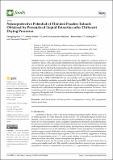Por favor, use este identificador para citar o enlazar a este item:
http://hdl.handle.net/10261/285147COMPARTIR / EXPORTAR:
 SHARE SHARE
 CORE
BASE CORE
BASE
|
|
| Visualizar otros formatos: MARC | Dublin Core | RDF | ORE | MODS | METS | DIDL | DATACITE | |

| Título: | Neuroprotective potential of thinned peaches extracts obtained by pressurized liquid extraction after different drying processes |
Autor: | Guo, Chongting; Valdés, Alberto CSIC ORCID; Sánchez-Martínez, J. David CSIC ORCID; Ibáñez, Elena CSIC ORCID ; Bi, Jinfeng; Cifuentes, Alejandro CSIC ORCID | Palabras clave: | Blood–brain barrier Thinned peach fruits Food by-products Polyphenols Neuroprotective activity PLE |
Fecha de publicación: | 2022 | Editor: | Multidisciplinary Digital Publishing Institute | Citación: | Foods 11(16): 2464 (2022) | Resumen: | Genetic, environmental and nutritional factors are suggested as primary factors of Alzheimer’s disease (AD), and secondary metabolites such as polyphenols present in thinned peaches are considered as good candidates for AD prevention. Thinned peaches are usually dried to avoid putrefaction, but the effects of the drying method and the extraction process on the polyphenol composition and the neuroprotective potential have never been addressed. In this work, a pressurized liquid extraction (PLE) method was optimized and applied to thinned peaches dried under different conditions, and their neuroprotective potential was evaluated in vitro. In addition, the PLE extracts were characterized via HPLC-Q-TOF-MS/MS, and a permeability assay was performed to evaluate the ability of the identified metabolites to cross the blood–brain barrier (BBB). The PLE extracts obtained from freeze-dried (FD) samples with 50% ethanol in water at 180 °C showed the best neuroprotective potential. Finally, among the 81 metabolites identified, isoferulic acid, 4-methyldaphnetin, coniferyl aldehyde and 3,4-dihydroxyacetophenone were found at higher concentrations in FD extracts. These metabolites are able to cross the BBB and are positively correlated with the neuroprotective potential, suggesting FD together with PLE extraction as the best combination to exploit the neuroprotective capacity of thinned peaches. | Descripción: | This article belongs to the Special Issue The Use of Green Solvents and Compressed Fluid Extraction Technologies in Food Science. | Versión del editor: | https://doi.org/10.3390/foods11162464 | URI: | http://hdl.handle.net/10261/285147 | DOI: | 10.3390/foods11162464 | E-ISSN: | 2304-8158 |
| Aparece en las colecciones: | (CIAL) Artículos |
Ficheros en este ítem:
| Fichero | Descripción | Tamaño | Formato | |
|---|---|---|---|---|
| neuroprotec.pdf | 2,38 MB | Adobe PDF |  Visualizar/Abrir |
CORE Recommender
PubMed Central
Citations
1
checked on 08-may-2024
SCOPUSTM
Citations
3
checked on 11-may-2024
WEB OF SCIENCETM
Citations
3
checked on 25-feb-2024
Page view(s)
25
checked on 15-may-2024
Download(s)
60
checked on 15-may-2024

